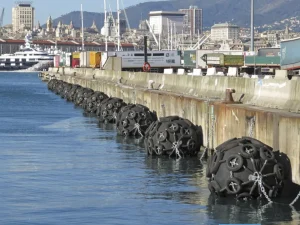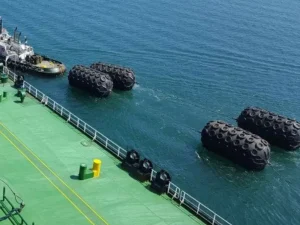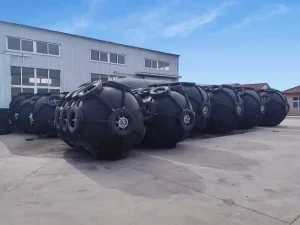Fenders are an integral component of the maritime industry. They enhance the safety and longevity of ships and vessels. Different types of fenders are available, but the Yokohama fenders are the most popular. Their unique characteristics make them stand out. Despite their excellent features, people ask: Why Choose Yokohama Fenders?
This question can be confusing to someone new to this industry. I know that the seniors are well-known for how good these fenders are! But newbies don’t get their scope. These fenders’ extensive usability makes them consider why they are prioritized over others. This article will explain these questions. In the end, you’ll have questions unheard!
Overview of Yokohama Fenders

Pneumatic or floating fenders are the other names for these Yokohama fenders. These are inflatable marine bumpers that protect ships from shocks. They were first made by a Yokohama company back in the 1950s. Due to this, they are known as Yokohama fenders. Their name represents the manufacturer.
Don’t be confused, as these Yokohama fenders are also rubber fenders. We have discussed the rubber fenders in our previous articles as well. Let’s talk about the manufacturing process of these Yokohama fenders. Remember, they are made of synthetic rubber. Why? This rubber is solid and capable of bearing extreme stress.
The body of these Yokohama fenders consists of multiple layers, which enhance their strength. The rubber, along with fabric reinforcement, ensures excellent strength. Moreover, these layers are further heated, which enhances their toughness. After that, the fenders undergo a shaping process.
During shaping, these fenders are tested for their inflation as well. Manufacturers inspect if they hold the air inside them or not. Additionally, their effectiveness of compression against shock is also a critical point. Here are the essential components of Yokohama fenders:
- Swivel
- Chains
- Flange
- Shackle
- Towing ring
- Rubber Sleeve
Once ready, they are installed on ships and vessels. Their compression is what makes them stand out. When ships dock, these fenders collide with the docking structures. So, these Yokohama fenders absorb the impact and behave like a cushion. The vessel does not feel the jerk and remains in good shape.
Why Should You Choose Yokohama Fenders?
You may argue all types of rubber fenders absorb impact. So, why should I use the Yokohama fenders? You’re right; their role in these fenders is similar to what you get with other fenders. However, their effectiveness and efficiency are what make them different from others. Let’s dive down and discuss why we chose Yokohama fenders.
1- Inflatable Design
The traditional fenders are solid and rigid, which makes them less efficient at absorbing shocks. As a result, the vessel also feels some jerks, indicating compromised protection. The Yokohama fenders, on the other hand, are inflatable. This means you can fill them with air. This is a convenient feature, as this air helps the fenders compress.
Compression divides the impact of shock evenly. This way, the Yokohama fenders absorb more impact energy, keeping the ship safe during the collision. The compression of these fenders adds to their flexibility. They can be used on heavy-duty vessels and can easily absorb extreme shocks.
2- Durability & Longevity
As I said earlier, the Yokohama fenders are mainly made with synthetic rubber. This material is solid and offers exceptional durability. So, these fenders are also very robust due to the use of this material. They can easily bear the extreme stress and impact. Moreover, their usability in harsh weather conditions does not deteriorate their quality. No other fenders come close to Yokohama when it comes to durability.
3- Versatile Applications
What I love about Yokohama fenders is their versatility. They can be used in different conditions. For example, different vessel operations use rubber fenders in the maritime industry. Those are as follows:
- Ship-to-Dock Mooring
- Offshore Oil and Gas Platforms
- Naval and Military Vessel Docking
- Container and Bulk Carrier Mooring
- Ship-to-Ship (STS) Transfer Operations
- Cargo Loading and Unloading Operations
The Yokohama fenders can be used in all these operations. You can install them either on the docking structures or on ships. Their functionality will be equally good in either case. The ship-to-ship transfer also utilizes these fenders. In this way, both ships come close to each other while moving. Their collision does not cause any jerk.
4- Resistant to Over-pressure
The marine industry does not only consist of small ships. Instead, it involves docking heavy-duty vessels that carry heavy loads. Their load puts extreme pressure and stress on the docking structures during docking. Those loads will destroy the socking structures if the fenders are not strong.
In such cases, these Yokohama fenders come in. They are made with durable rubber material. As a result, they can efficiently bear extreme pressures and maintain their integrity. This capability of absorbing extreme shocks makes them stand out. Yokohama fenders make docks ready to handle any range of vessels with ease.
5- Cost-Effective & Affordability
Marine fenders have different pricing and quality. Some of them are very expensive. Manufacturers advertise them as high-end or premium fenders. On the flip side, some are cheap but don’t work efficiently. These Yokohama fenders lie in the middle. Their pricing is not too high.
But their efficacy is better than that of premium or high-end rubber fenders. Therefore, these are considered value for money. If you look at their quality in terms of pricing, these fenders offer exceptional value. Their affordable pricing is what makes people buy them. In short, Yokohama fenders provide a balance between price and quality.
How to Choose the Right Yokohama Fenders?

A Japanese company makes Yokohama fenders with an excellent quality assurance system. So, you don’t worry about their performance. However, you’ll have to be careful when choosing their size and tonnage during selection. The wrong size will not serve the purpose effectively. Remember, different ships have different sizes.
Therefore, their selection should be based on the size of the ships. Along with size, you should also remember the pressure rating. It indicates how much pressure a fender can easily bear or absorb. Here is the table showing specific size and pressure ratings for wise decisions.
| Fender Size (Diameter x Length) | Pressure Rating (kPa) |
|---|---|
| 0.5 m x 1.0 m | 50 kPa |
| 1.0 m x 1.5 m | 50-80 kPa |
| 1.2 m x 2.0 m | 50-80 kPa |
| 2.0 m x 3.5 m | 80-100 kPa |
| 2.5 m x 5.5 m | 80-100 kPa |
| 3.3 m x 6.5 m | 100-150 kPa |
The smaller-sized fenders are suitable for small boats. They have a small pressure-bearing capacity. On the flip side, the more large fenders suit the bigger vessels. They have higher pressure-bearing capacity. You should choose the fender size based on the size of your ship or vessel.
Why Are Pneumatic Fenders Also Called Yokohama Fenders?

As I said above, both pneumatic and Yokohama fenders are the same. In simple words, they are two names for one thing. However, the question remains as to why pneumatic fenders are more commonly called Yokohama. The reason is that the Yokohama company first made the pneumatic fenders.
This is a Japanese company that works to produce fenders and other rubber-made products. This company found pneumatic fenders back in 1958. Due to this invention, the pneumatic fenders are named Yokohama. Before 1958, there were no pneumatic fenders. The marine industries had to use solid ones that were not reliable.
Ordering Yokohama fenders for your ship? You might be consumed by what name you should use when ordering pneumatic fenders from a supplier, right? You can either mention pneumatic or Yokohama fenders. All the suppliers understand that these fenders have multiple names. You can even call them floating fenders. Remember, all these names indicate the same thing.
Conclusion
The Yokohama fenders have become very trendy in the marine industry. Almost all the ships and vessels use them to ensure their safety and protection. There are many reasons behind their popularity. Shock absorption, durability, and cost-effectiveness are at the top. In this guide, I’ve explained everything related to these fenders. Hopefully, you’ll now be able to make informed decisions while choosing these fenders.
